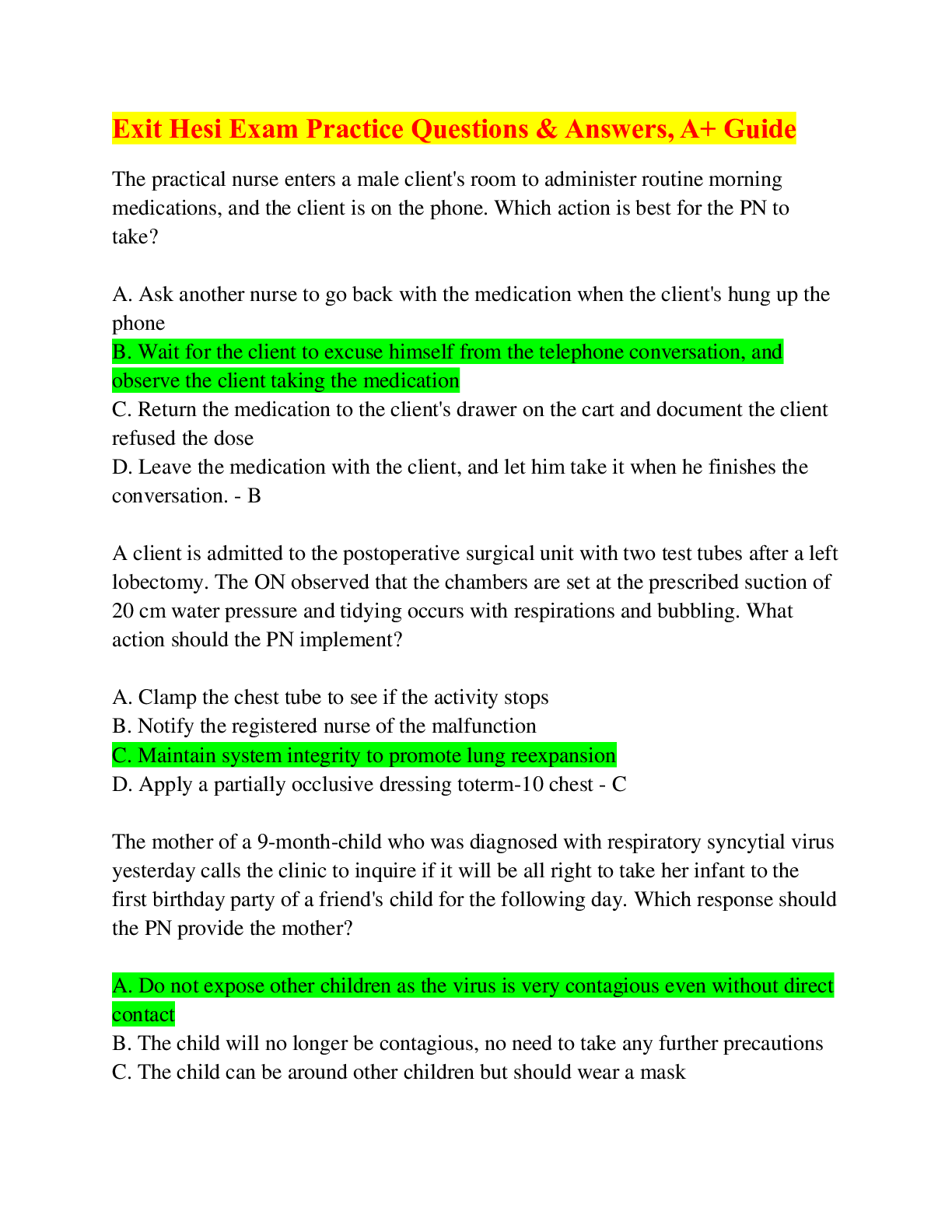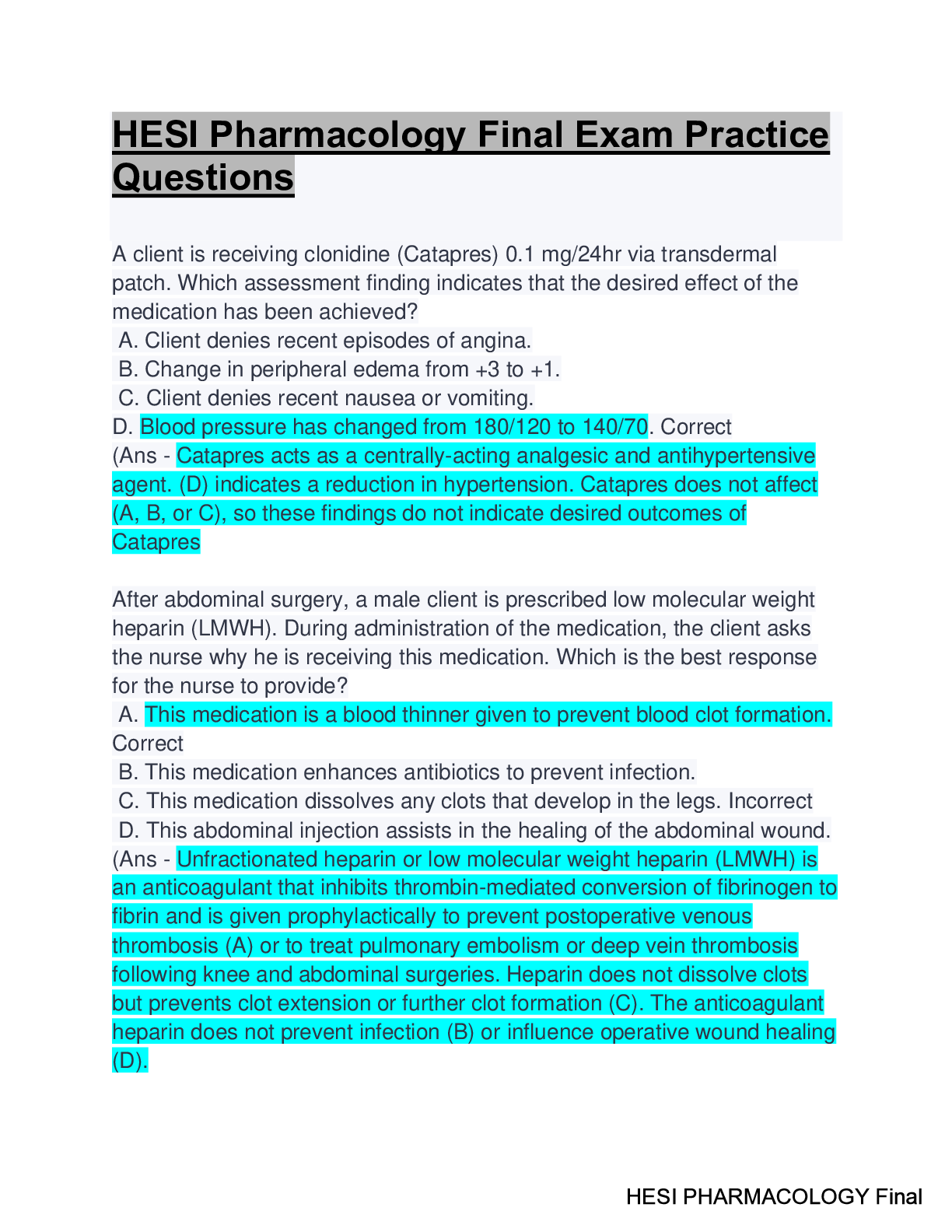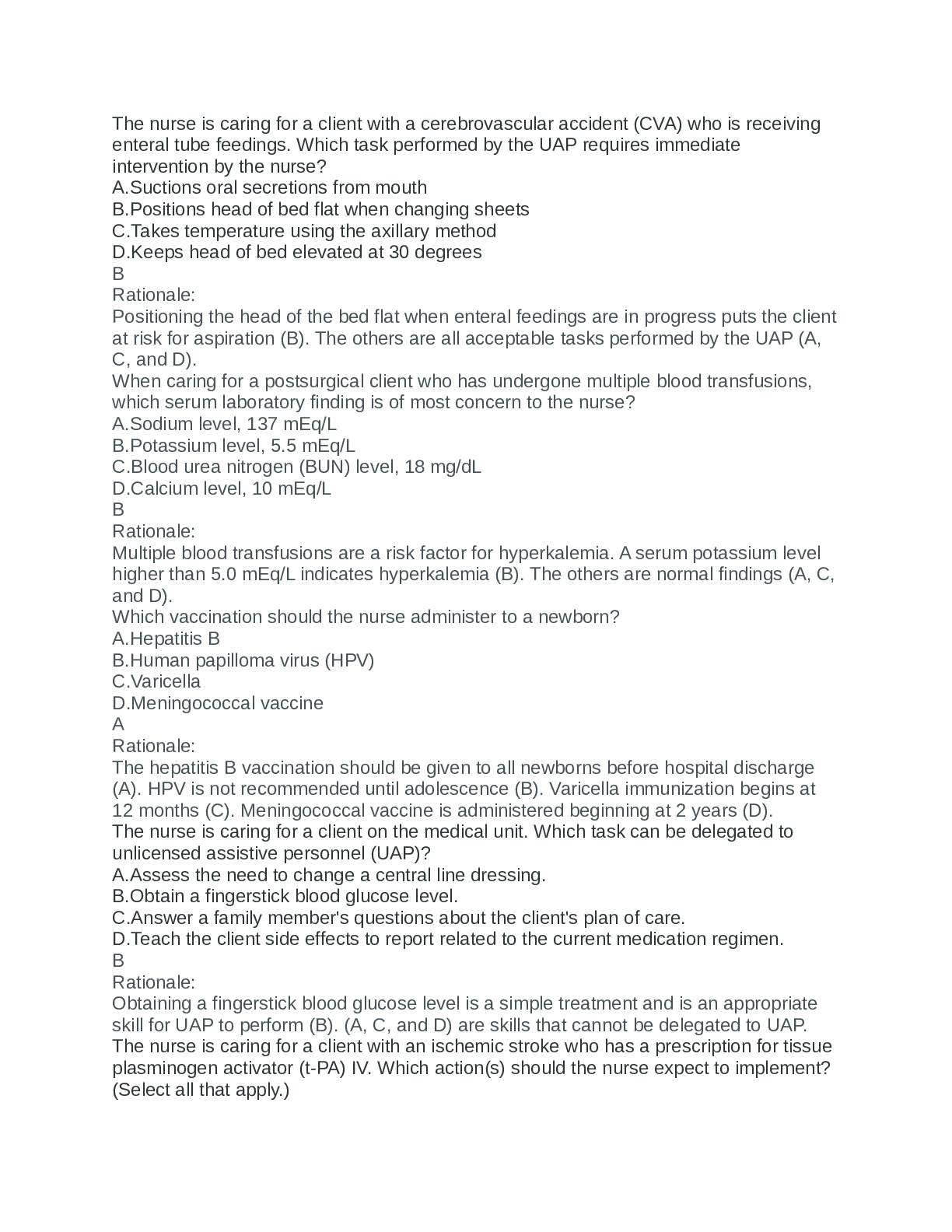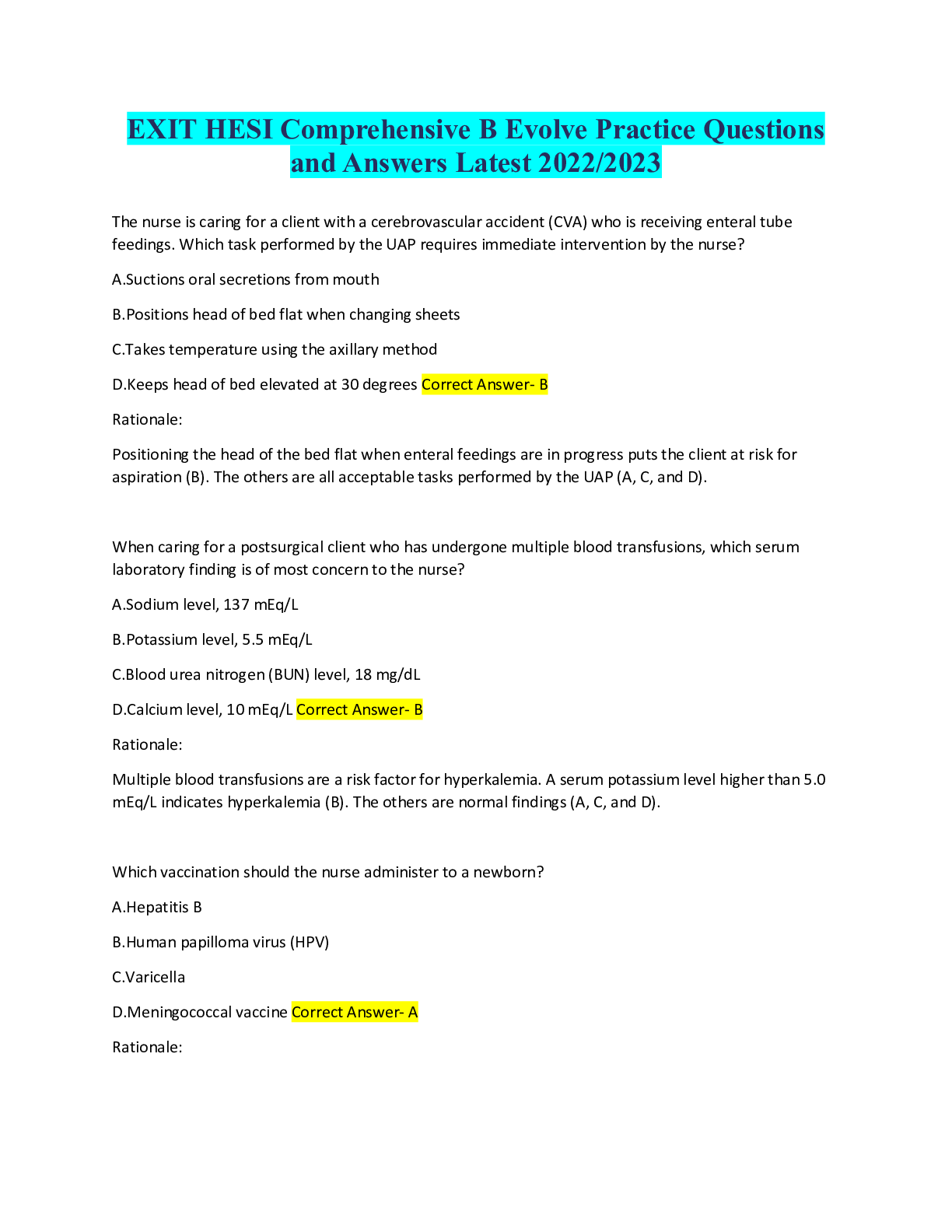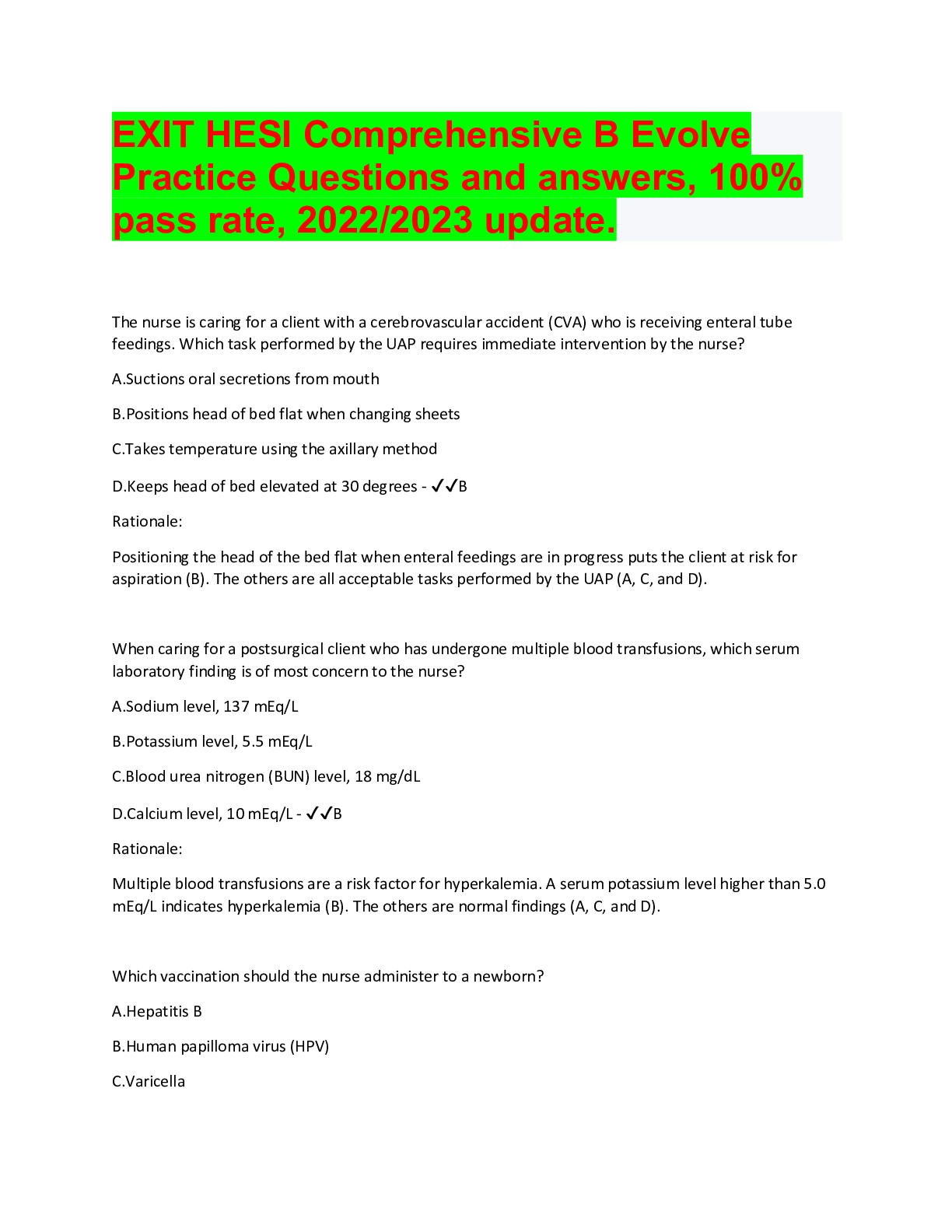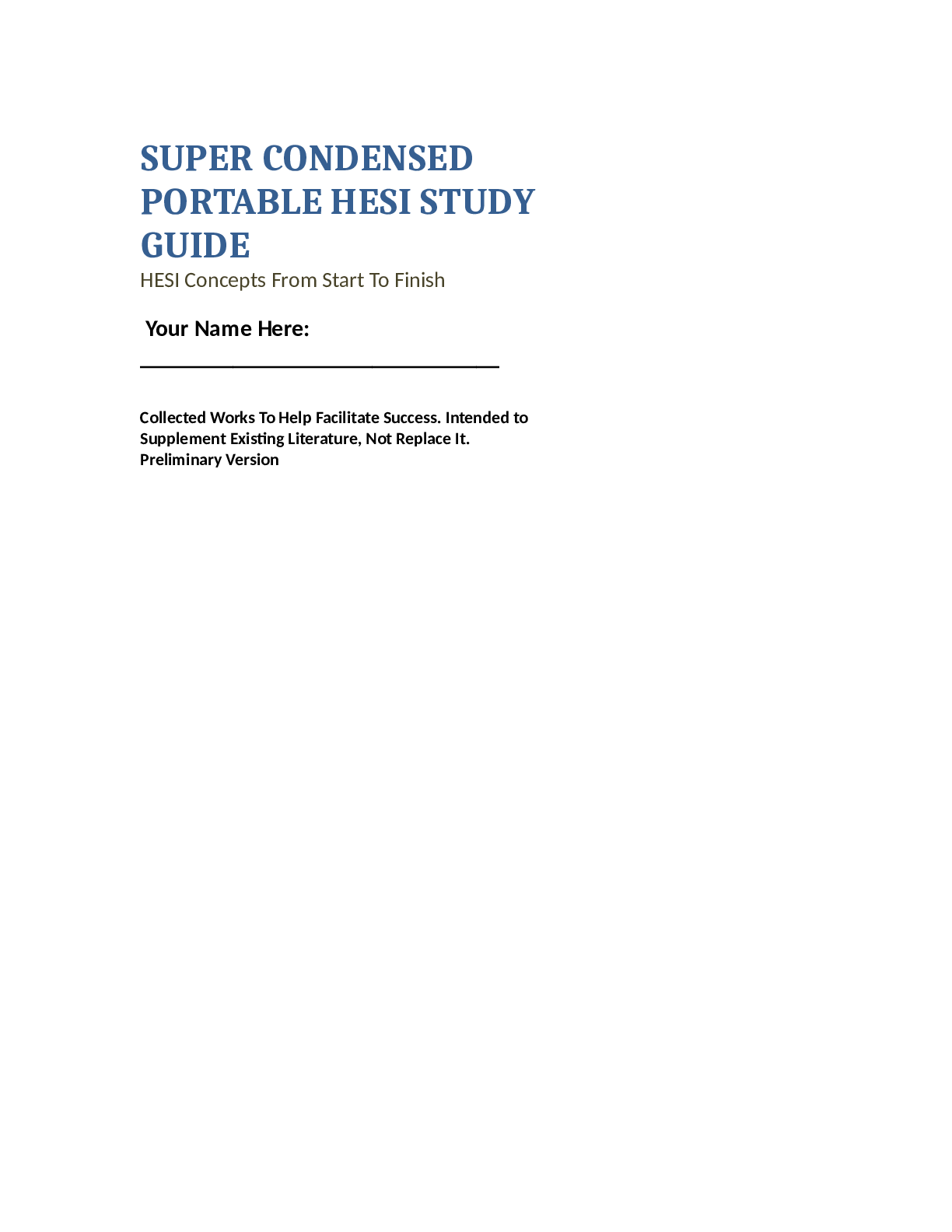Health Care > HESI > HESI Exit Comprehensive B Evolve Practice Questions & Answers/ Latest Updated (All)
HESI Exit Comprehensive B Evolve Practice Questions & Answers/ Latest Updated
Document Content and Description Below
The nurse is caring for a client with a cerebrovascular accident (CVA) who is receiving enteral tube feedings. Which task performed by the UAP requires immediate intervention by the nurse? A.Suctions... oral secretions from mouth B.Positions head of bed flat when changing sheets C.Takes temperature using the axillary method D.Keeps head of bed elevated at 30 degrees (ANS- B Rationale: Positioning the head of the bed flat when enteral feedings are in progress puts the client at risk for aspiration (B). The others are all acceptable tasks performed by the UAP (A, C, and D). When caring for a postsurgical client who has undergone multiple blood transfusions, which serum laboratory finding is of most concern to the nurse? A.Sodium level, 137 mEq/L B.Potassium level, 5.5 mEq/L C.Blood urea nitrogen (BUN) level, 18 mg/dL D.Calcium level, 10 mEq/L (ANS-B Rationale: Multiple blood transfusions are a risk factor for hyperkalemia. A serum potassium level higher than 5.0 mEq/L indicates hyperkalemia (B). The others are normal findings (A, C, and D). Which vaccination should the nurse administer to a newborn? A.Hepatitis B B.Human papilloma virus (HPV) C.Varicella D.Meningococcal vaccine (ANS- A Rationale: The hepatitis B vaccination should be given to all newborns before hospital discharge (A). HPV is not recommended until adolescence (B). Varicella immunization begins at 12 months (C). Meningococcal vaccine is administered beginning at 2 years (D). The nurse is caring for a client on the medical unit. Which task can be delegated to unlicensed assistive personnel (UAP)? A.Assess the need to change a central line dressing. B.Obtain a fingerstick blood glucose level. C.Answer a family member's questions about the client's plan of care. D.Teach the client side effects to report related to the current medication regimen. (ANS- B Rationale: Obtaining a fingerstick blood glucose level is a simple treatment and is an appropriate skill for UAP to perform (B). (A, C, and D) are skills that cannot be delegated to UAP. The nurse is caring for a client with an ischemic stroke who has a prescription for tissue plasminogen activator (t-PA) IV. Which action(s) should the nurse expect to implement? (Select all that apply.) A.Administer aspirin with tissue plasminogen activator (t-PA). B.Complete the National Institute of Health Stroke Scale (NIHSS). C.Assess the client for signs of bleeding during and after the infusion. D.Start t-PA within 6 hours after the onset of stroke symptoms. E.Initiate multidisciplinary consult for potential rehabilitation. (ANS- B,C,E Rationale: Neurologic assessment, including the NIHSS, is indicated for the client receiving t-PA. This includes close monitoring for bleeding during and after the infusion; if bleeding or other signs of neurologic impairment occur, the infusion should be stopped (B, C, and E). Aspirin is contraindicated with t-PA because it increases the risk for bleeding (A). The administration of t-PA within 6 hours of symptoms is concurrent with a diagnosis of a myocardial infarction and within 4.5 hours of symptoms is concurrent for a stroke (D). When caring for a client in labor, which finding is most important to report to the primary health care provider? A.Maternal heart rate, 90 beats/min. B.Fetal heart rate, 100 beats/min C.Maternal blood pressure, 140/86 mm Hg D.Maternal temperature, 100.0° F (ANS- B Rationale: A fetal heart rate (FHR) of 100 beats/min may indicate fetal distress (B) because the average FHR at term is 140 beats/min and the normal range is 110 to beats/min 160. The others (A, C, and D) are normal findings for a woman in labor. The nurse is caring for a client with heart failure who develops respiratory distress and coughs up pink frothy sputum. Which action should the nurse take first? A.Draw arterial blood gases. B.Notify the primary health care provider. C.Position in a high Fowler's position with the legs down. D.Obtain a chest X-ray. (ANS- C Rationale: Positioning the patient in a high Fowler's position with dangling feet will decrease further venous return to the left ventricle (C). The other actions should be performed after the change in position (A, B, and D). A client who is prescribed chlorpromazine HCl (Thorazine) for schizophrenia develops rigidity, a shuffling gait, and tremors. Which action by the nurse is most important?A.Administer a dose of benztropine mesylate (Cogentin) PRN. B.Determine if the client has increased photosensitivity. C.Provide comfort measures for sore muscles. D.Assess the client for visual and auditory hallucinations. (ANS- A Rationale: Rigidity, shuffling gait, pill-rolling hand movements, tremors, dyskinesia, and masklike face are extrapyramidal side effects associated with Thorazine. It is most important for the nurse to administer an anticholinergic such as Cogentin to reverse these effects (A). The others (B, C, D) may be appropriate interventions but are not as urgent as (A). A nurse is interviewing a mother during a well-child visit. Which finding would alert the nurse to continue further assessment of the infant? A.Two-month-old who is unable to roll from back to abdomen B.Ten-month-old who cannot sit without support C.Nine-month-old who cries when his mother leaves the room D.Eight-month-old who has not yet begun to speak words (ANS- B Rationale: As a developmental milestone, infants should sit unsupported by 8 months (B). The milestone of rolling over is achieved at 5 to 6 months for most infants (A). Stranger anxiety is common from 7 to 9 months (C). Speaking a few words is expected at about 12 months (D). Which intervention should be included in the plan of care for a client admitted to the hospital with ulcerative colitis? A.Administer stool softeners. B.Place the client on fluid restriction. C.Provide a low-residue diet. D.Add a milk product to each meal. (ANS- C Rationale: A low-residue diet (C) will help decrease symptoms of diarrhea, which are clinical manifestations of ulcerative colitis. (A, B, and D) are contraindicated and could worsen the condition. The nurse is caring for a client with deep vein thrombosis who is on a continuous IV heparin infusion. The activated partial prothrombin time (aPTT) is 120 seconds. Which action should the nurse take? A.Increase the rate of the heparin infusion using a nomogram. B.Decrease the heparin infusion rate and give vitamin K IM. C.Continue the heparin infusion at the current prescribed rate. D.Stop the heparin drip and prepare to administer protamine sulfate. (ANS- D Rationale: An aPTT more than 100 seconds is a critically high value; therefore, the heparin should be stopped. The antidote for heparin is protamine sulfate (D). Increasing the rate would increase the risk for hemorrhage (A). The infusion should be stopped, and vitamin K is the antidote for warfarin (Coumadin) (B). Keeping the infusion at the current rate would increase the risk for hemorrhage (C). [Show More]
Last updated: 1 year ago
Preview 1 out of 41 pages
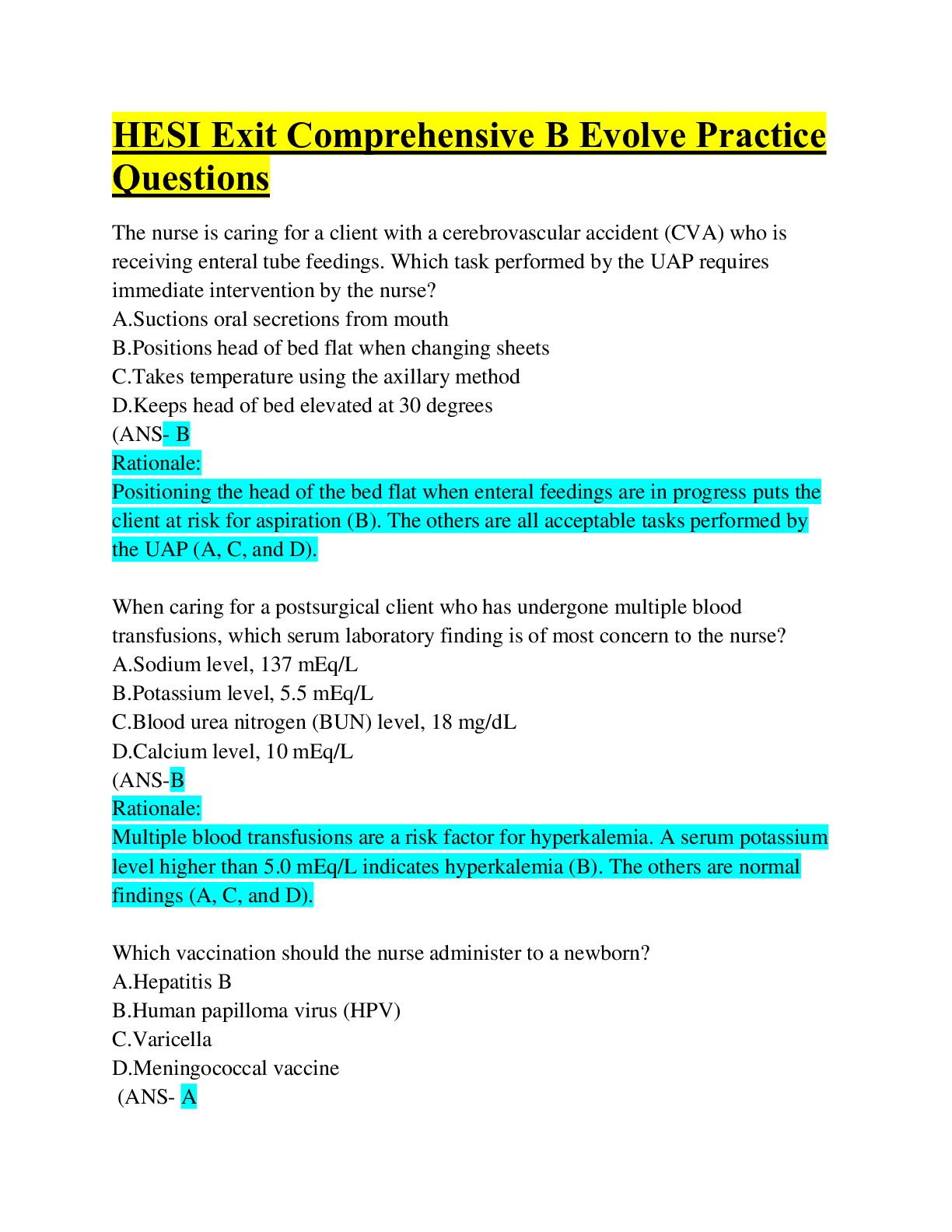
Reviews( 0 )
Document information
Connected school, study & course
About the document
Uploaded On
Jun 25, 2022
Number of pages
41
Written in
Additional information
This document has been written for:
Uploaded
Jun 25, 2022
Downloads
0
Views
38

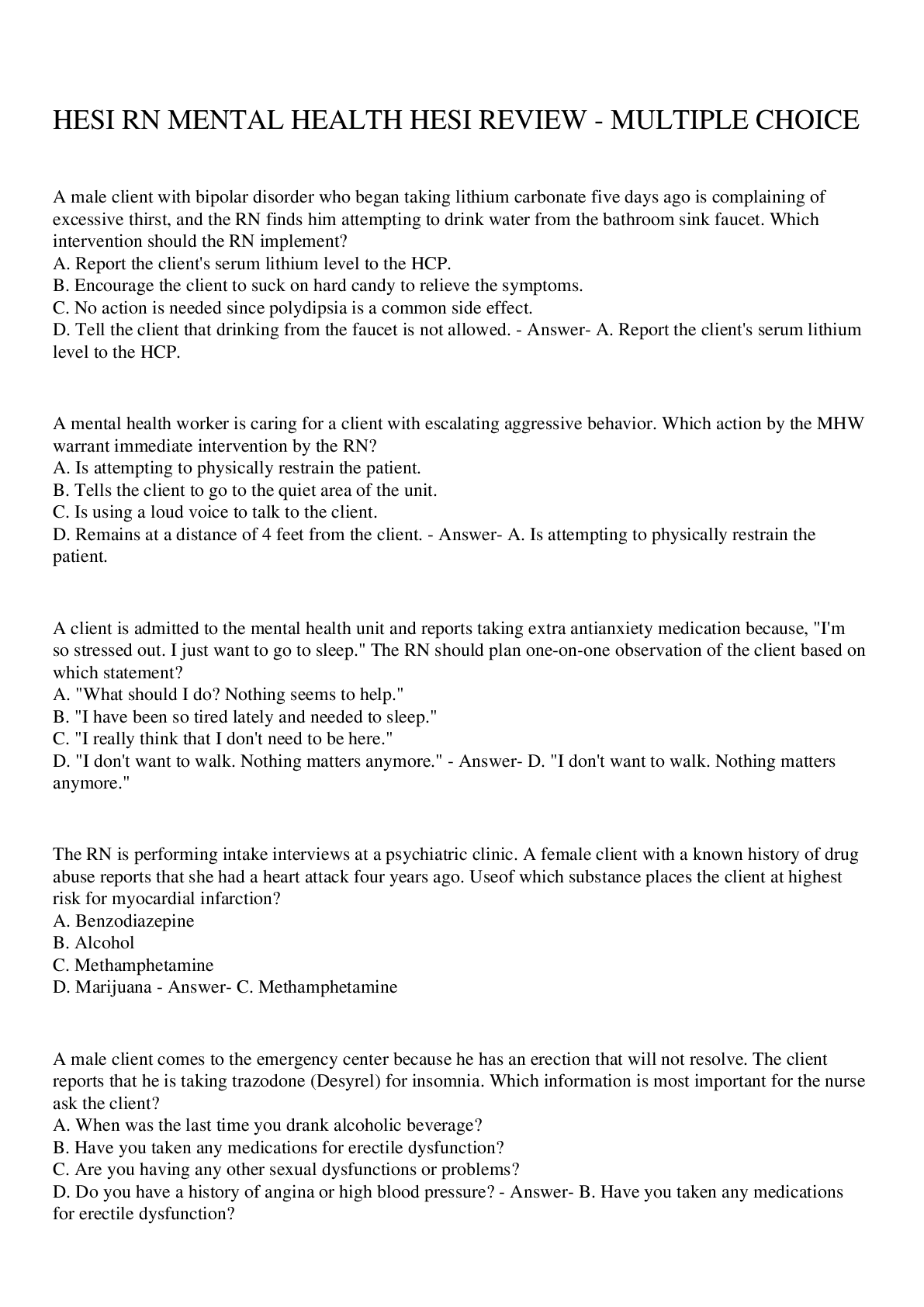
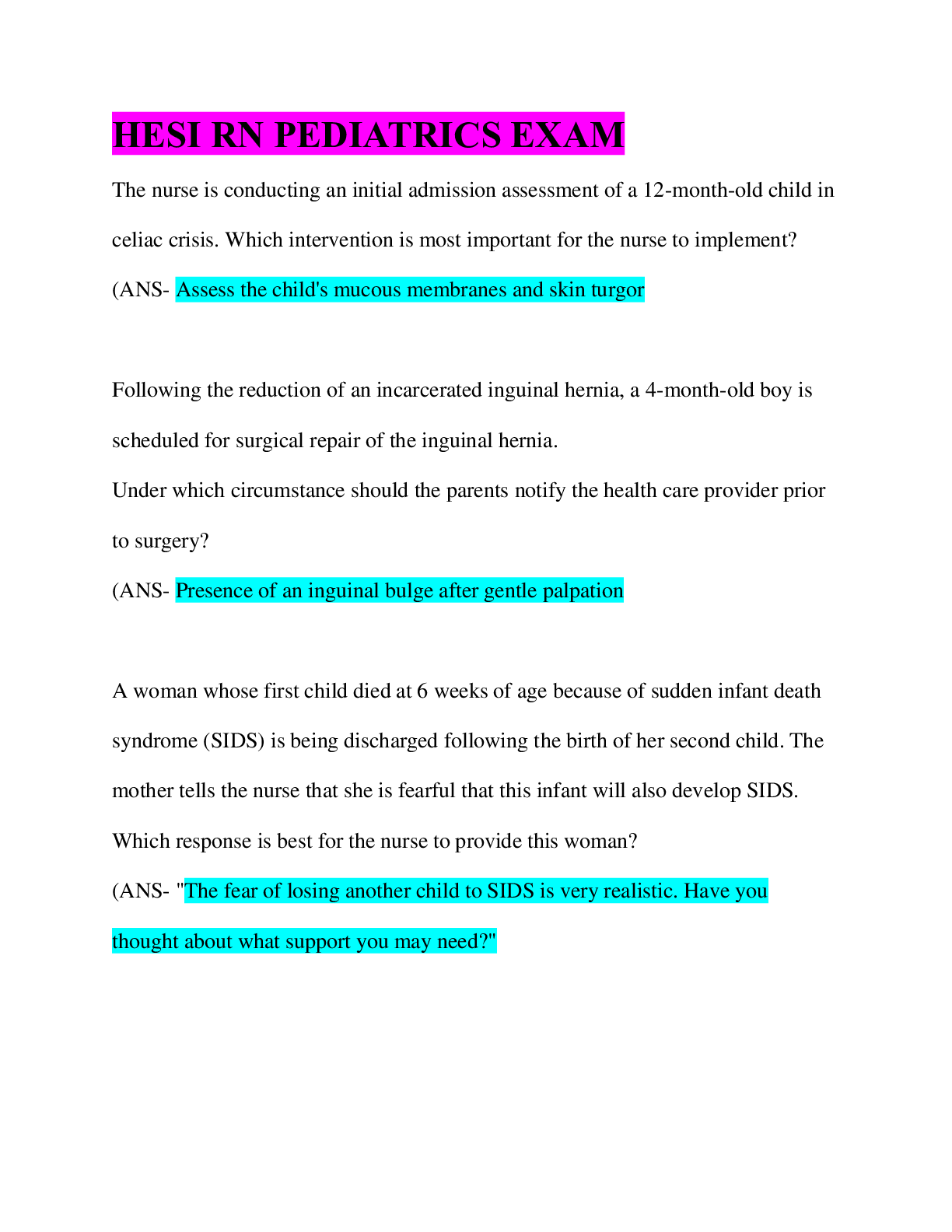
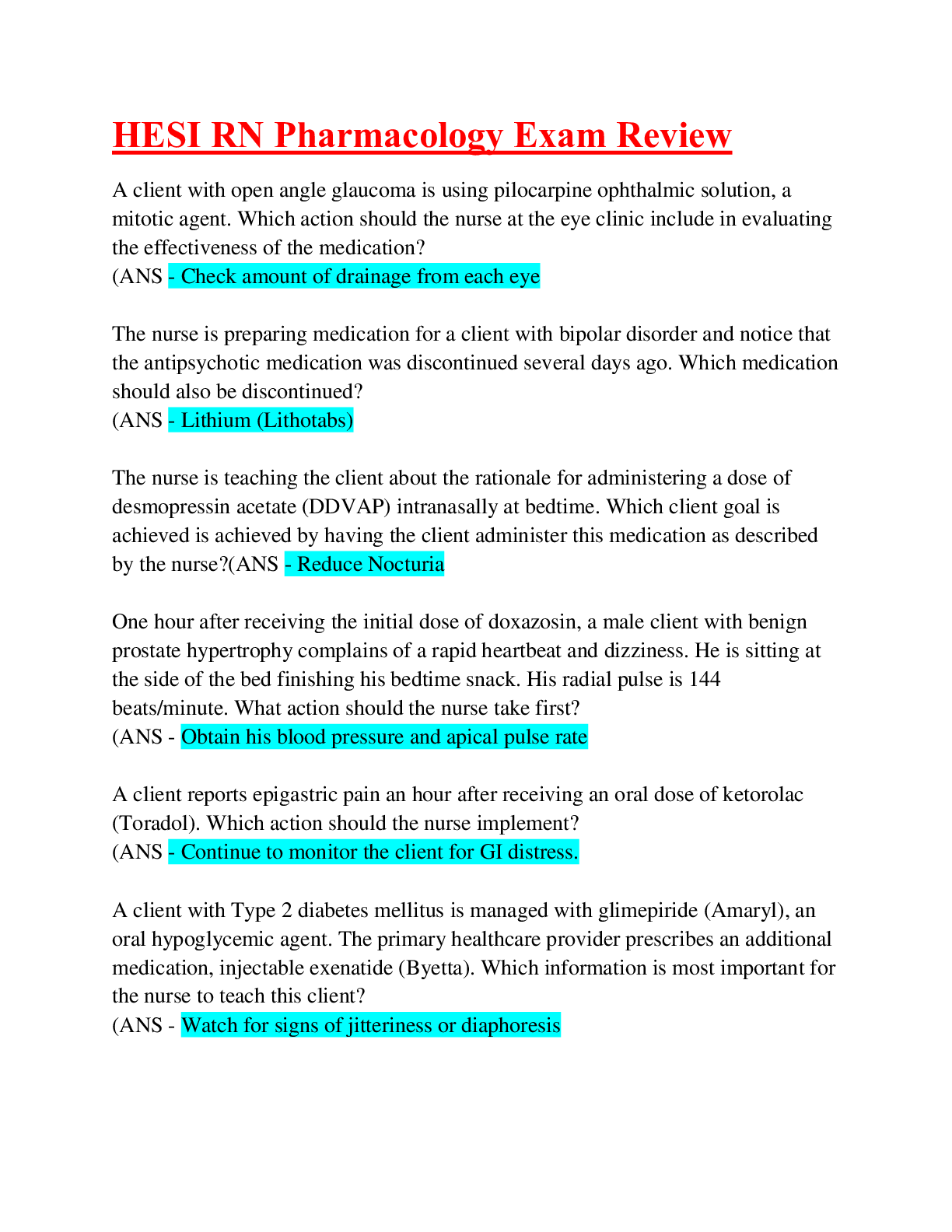
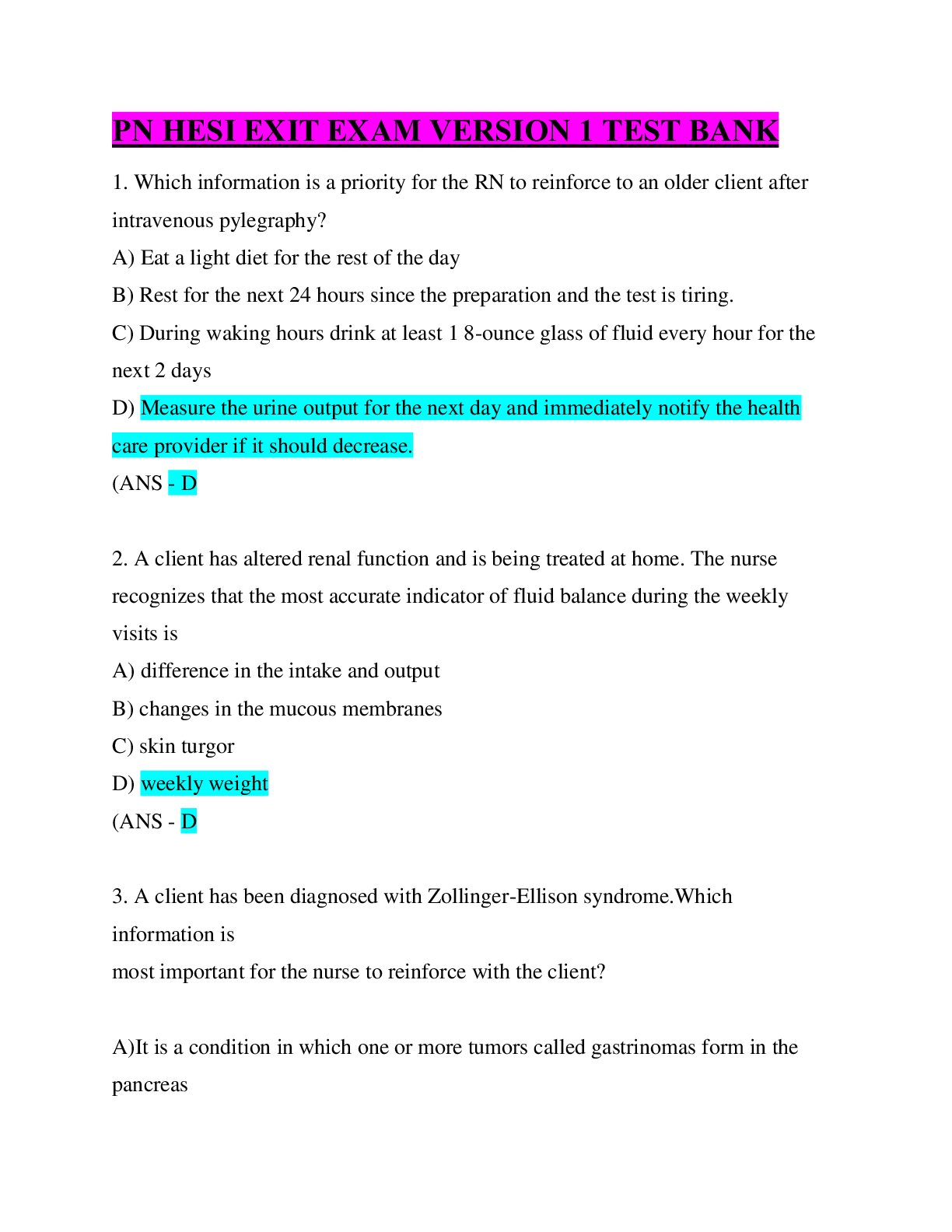
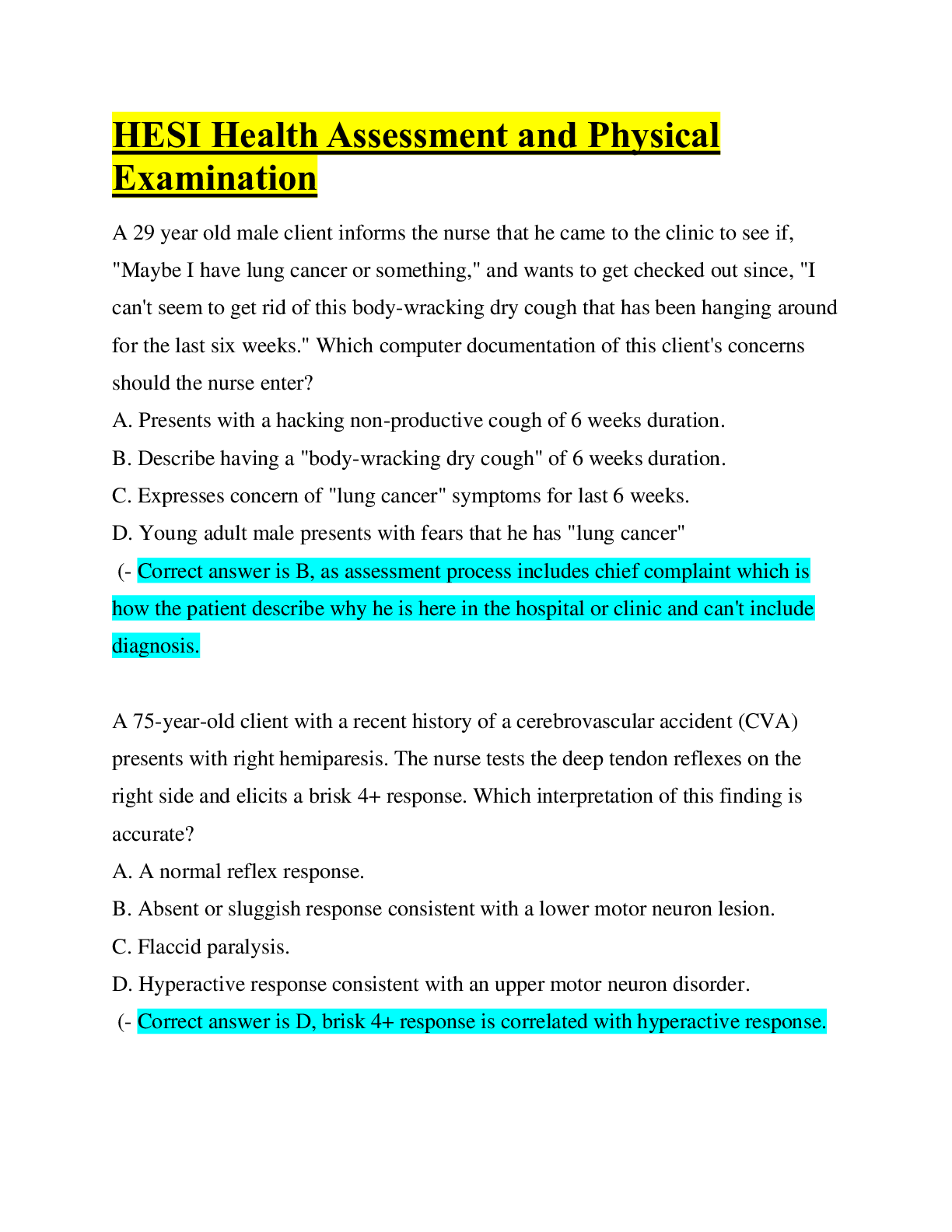
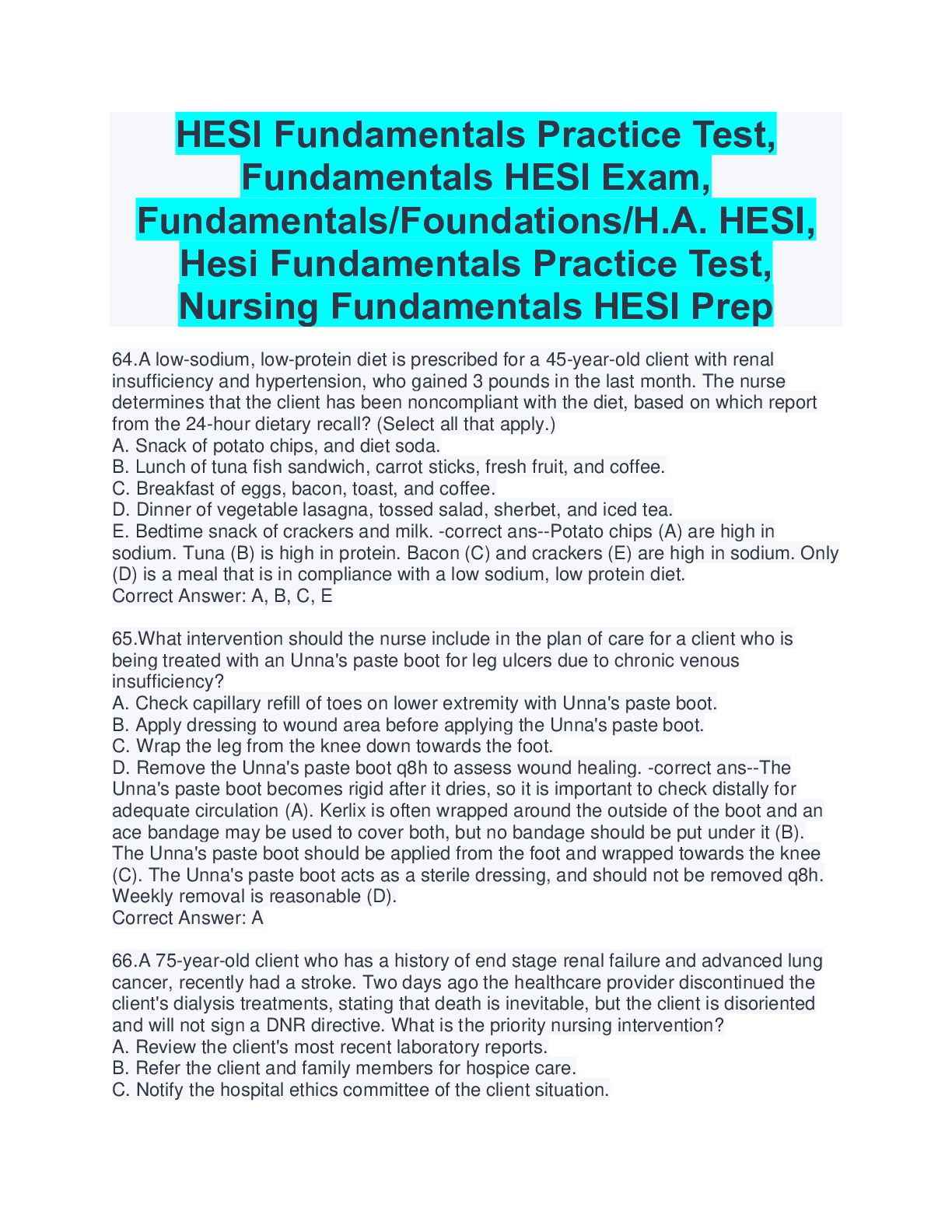
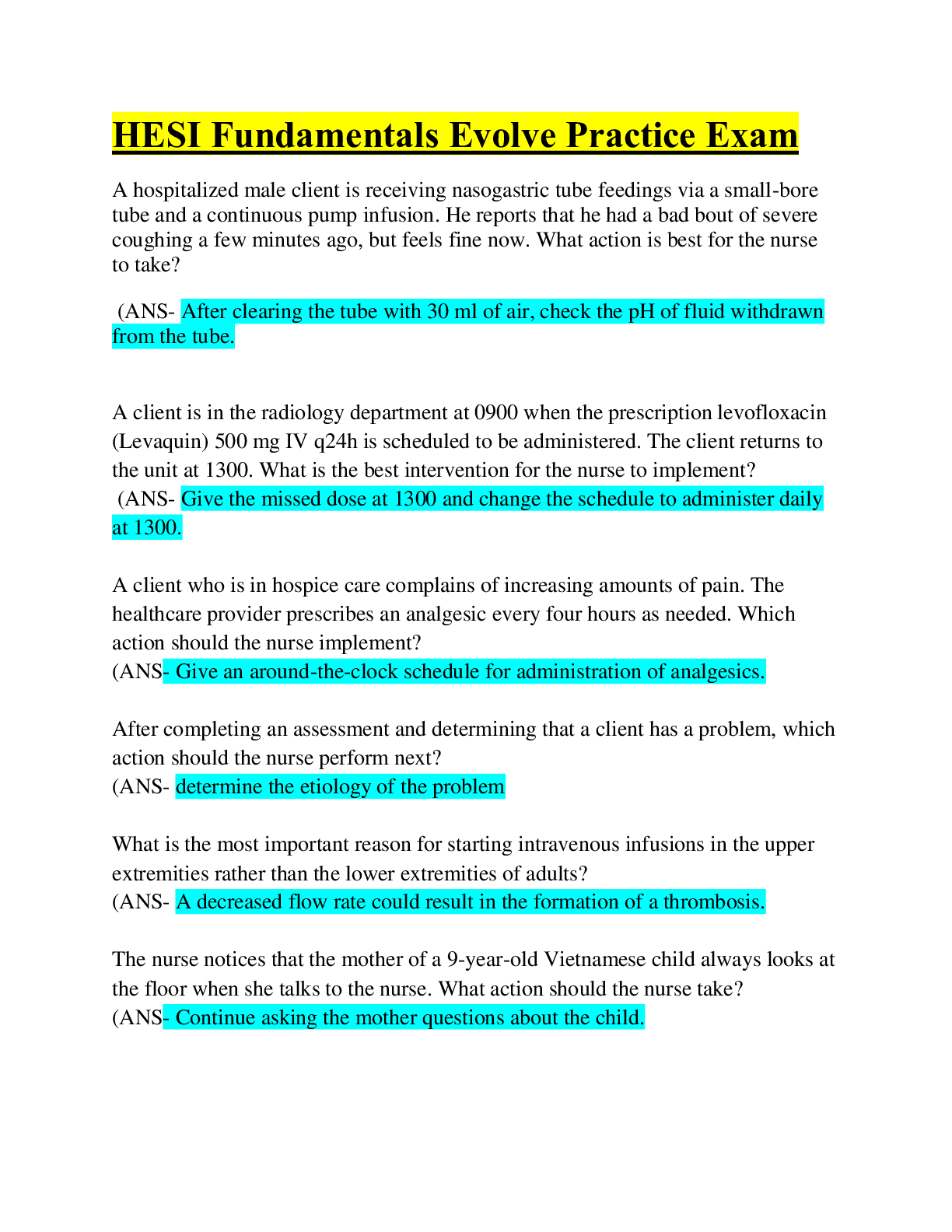

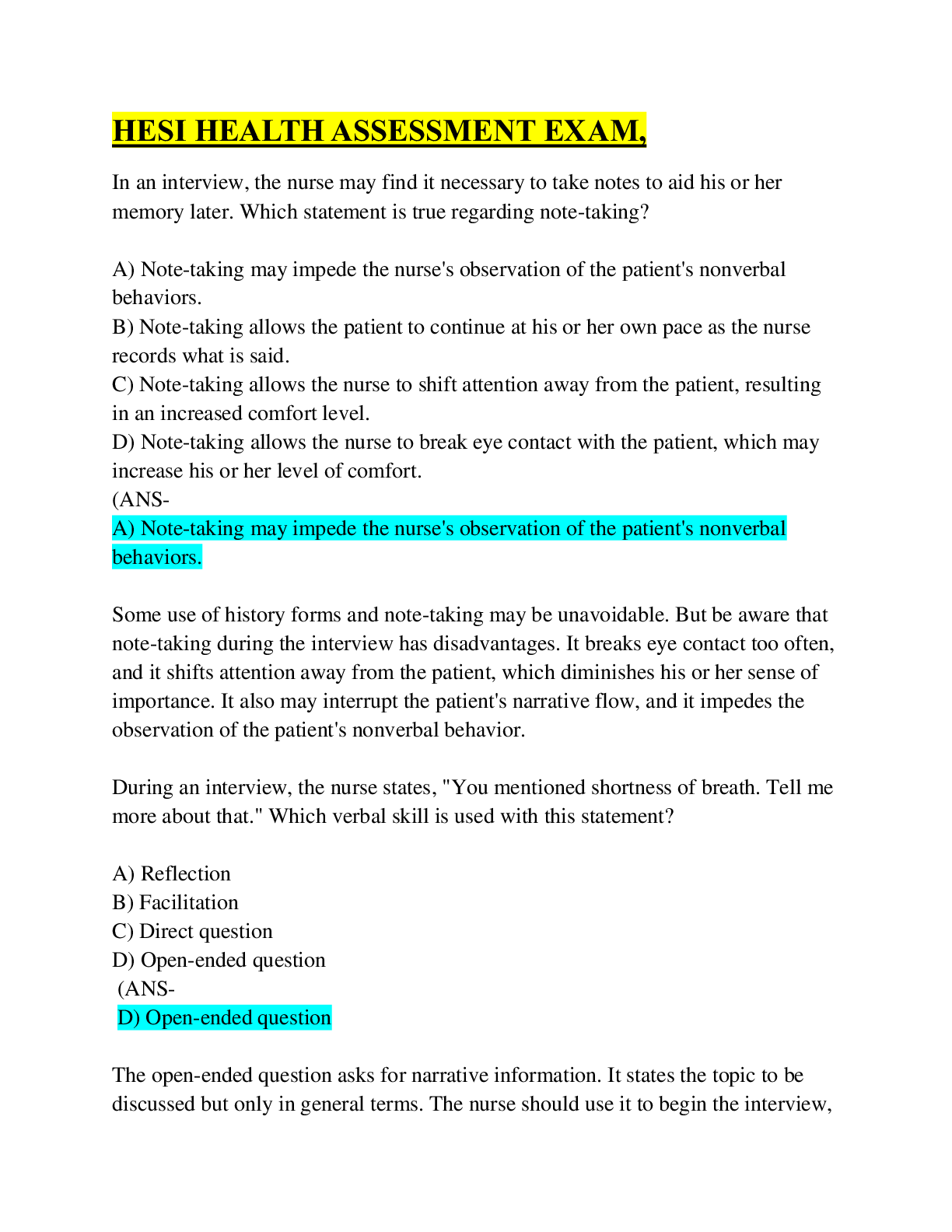
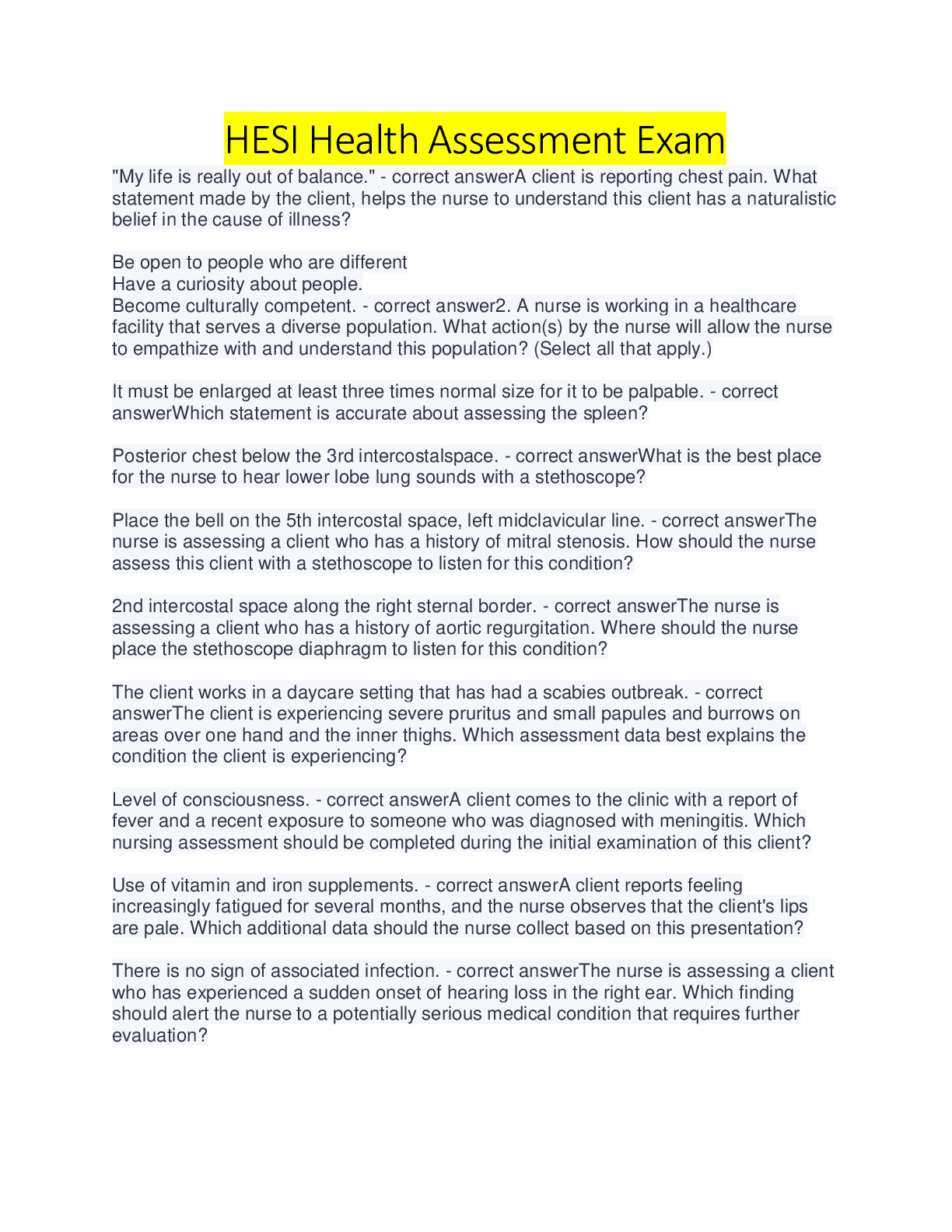
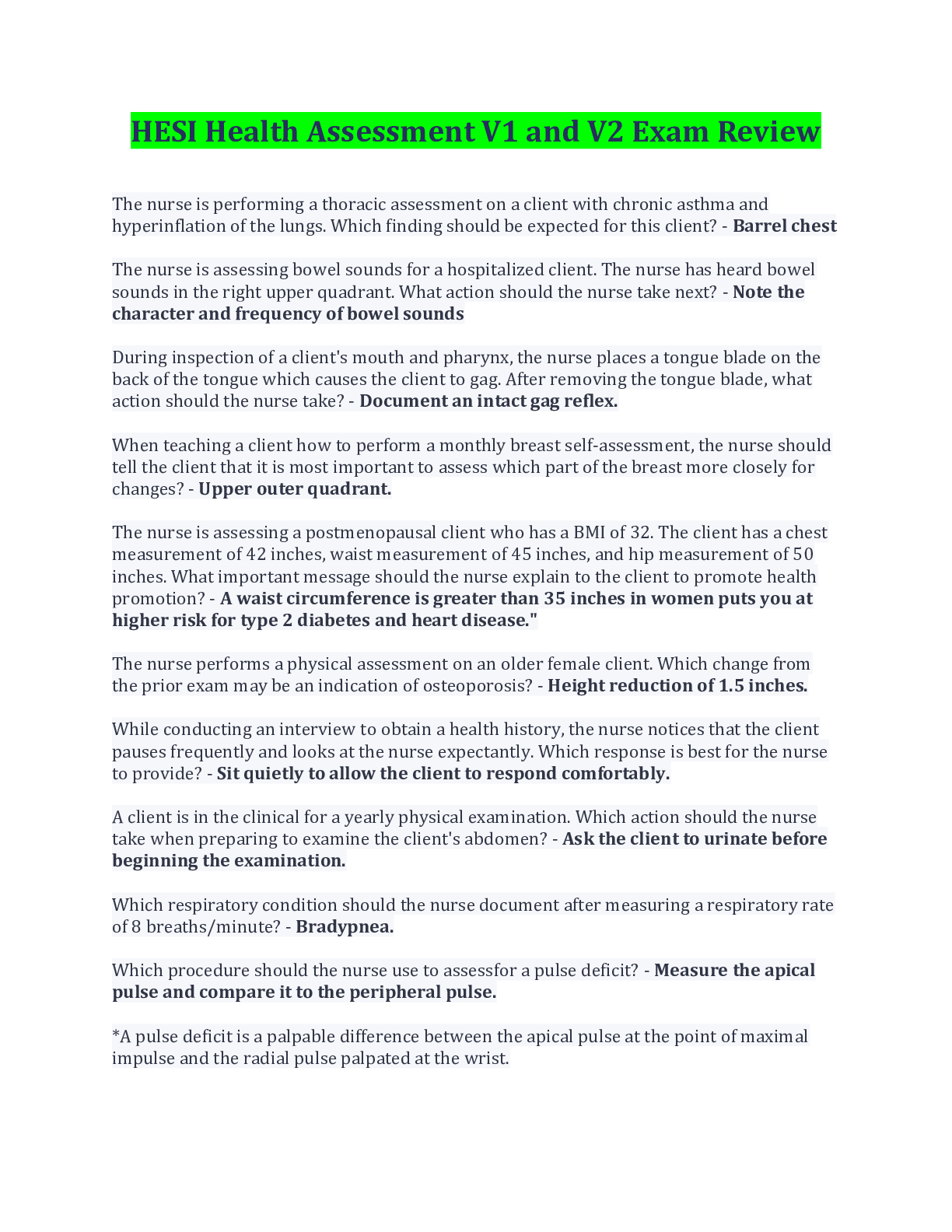
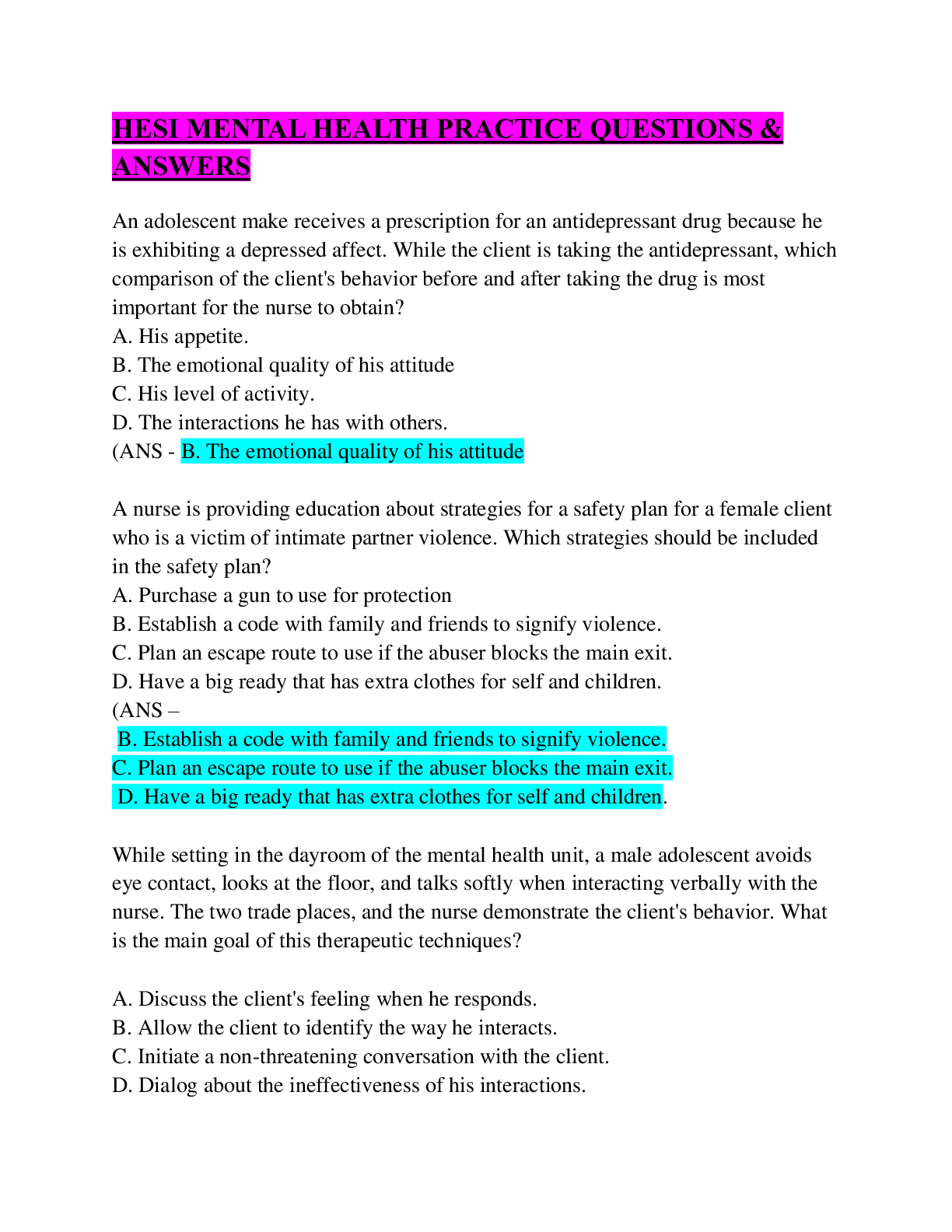
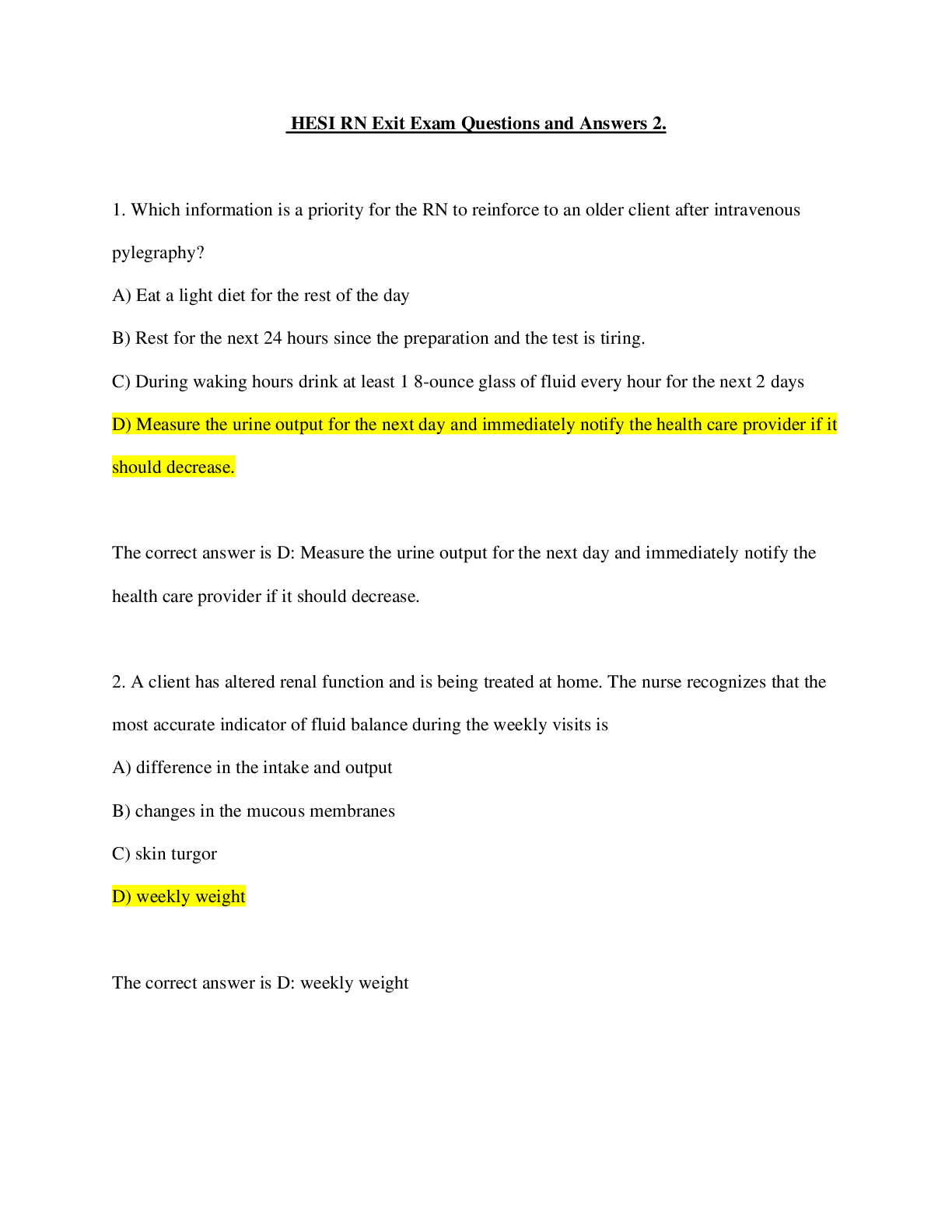
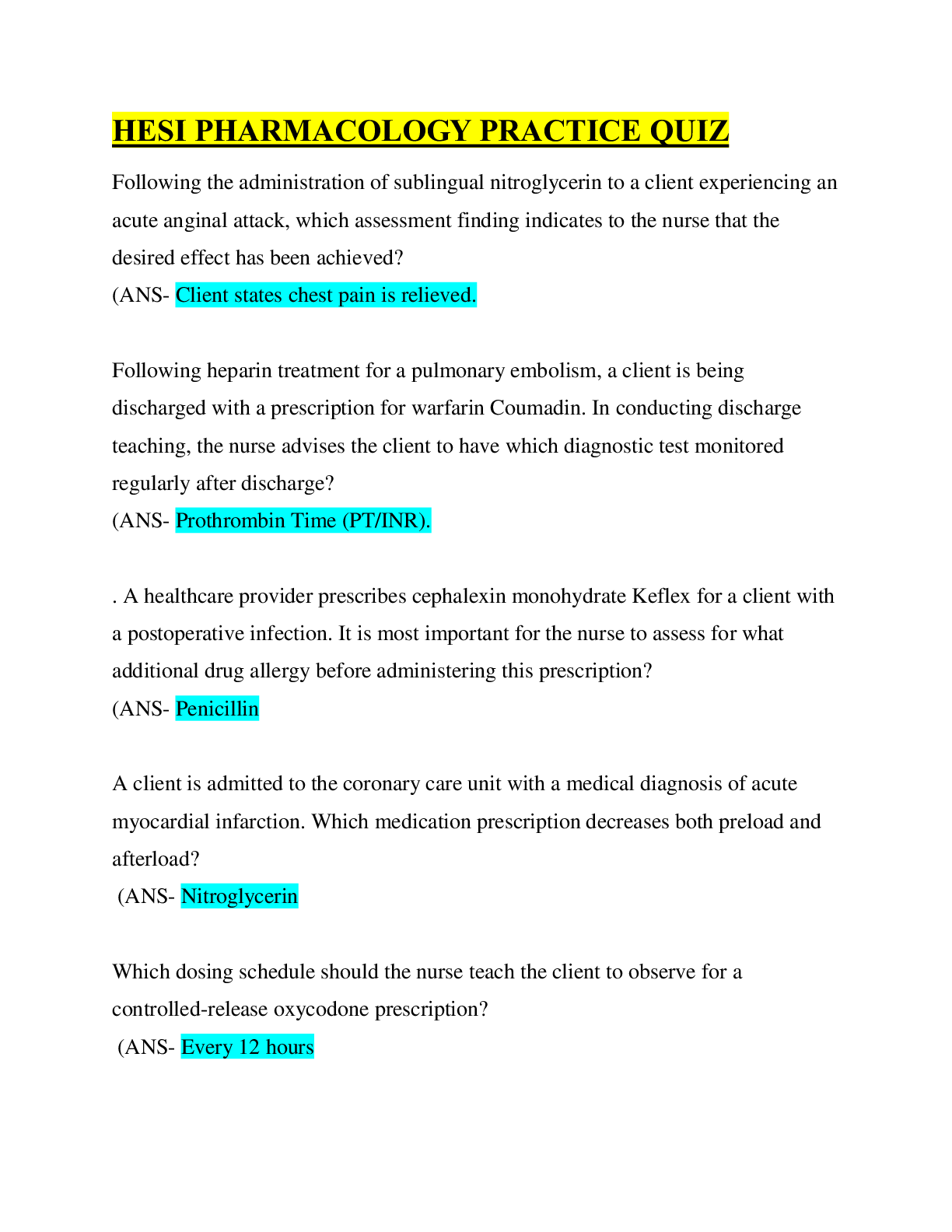
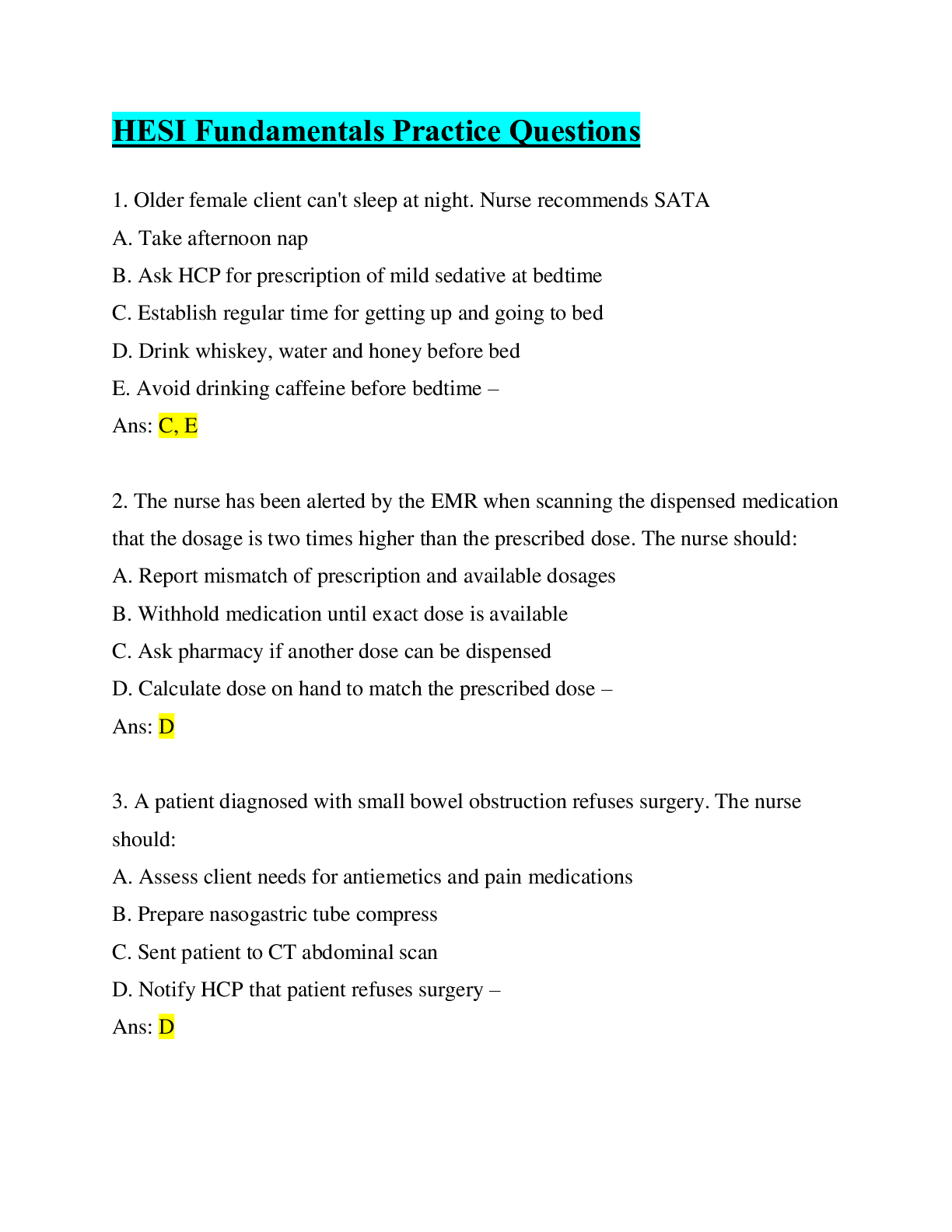
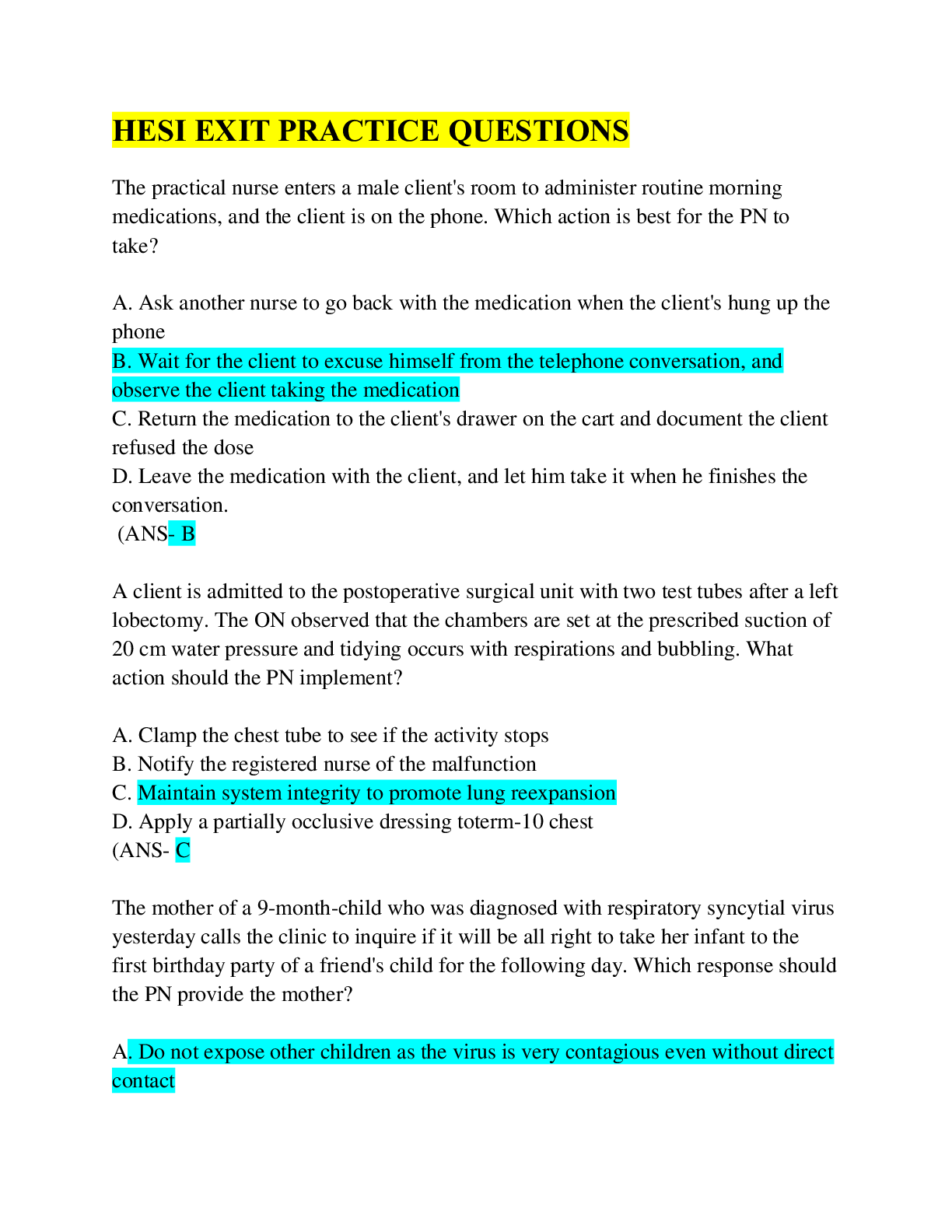
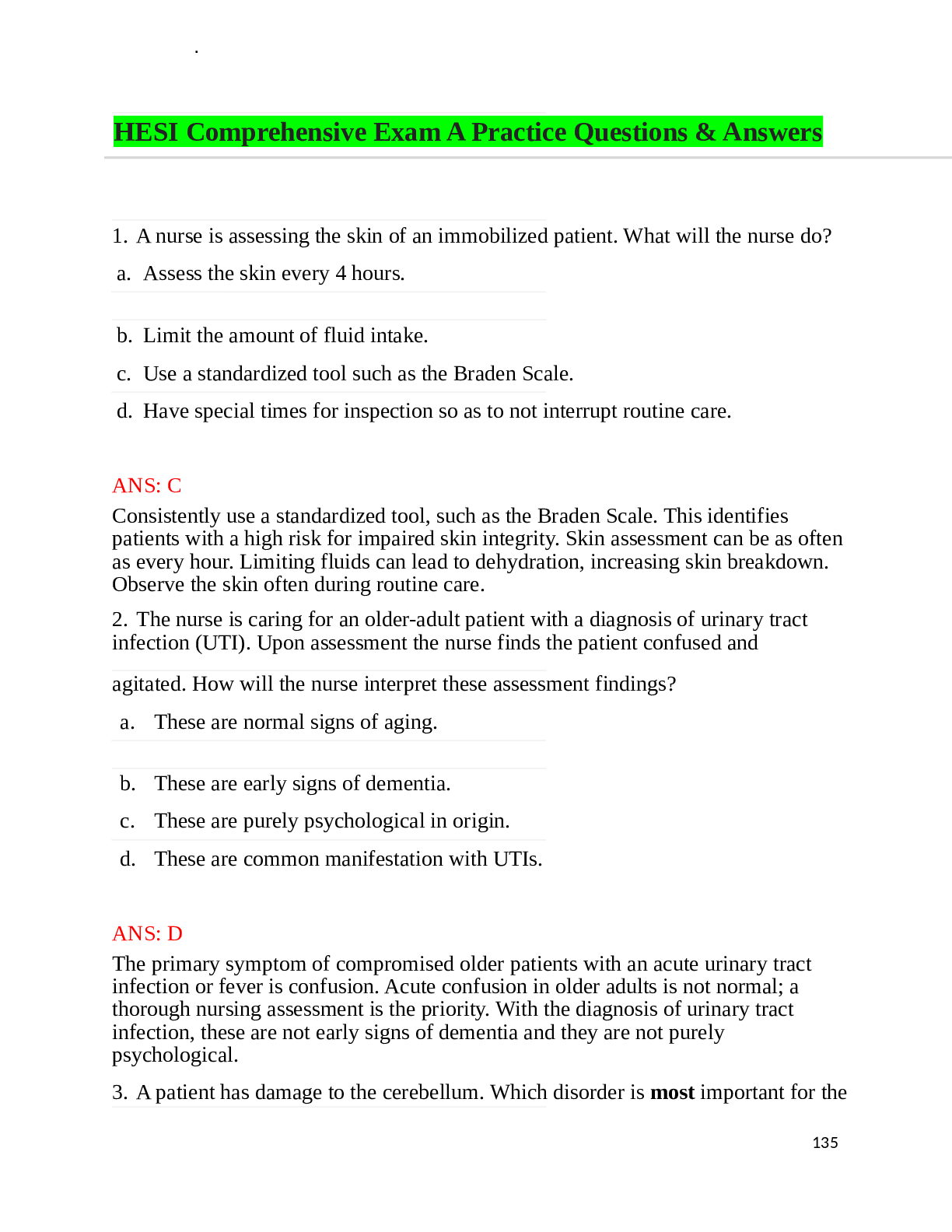
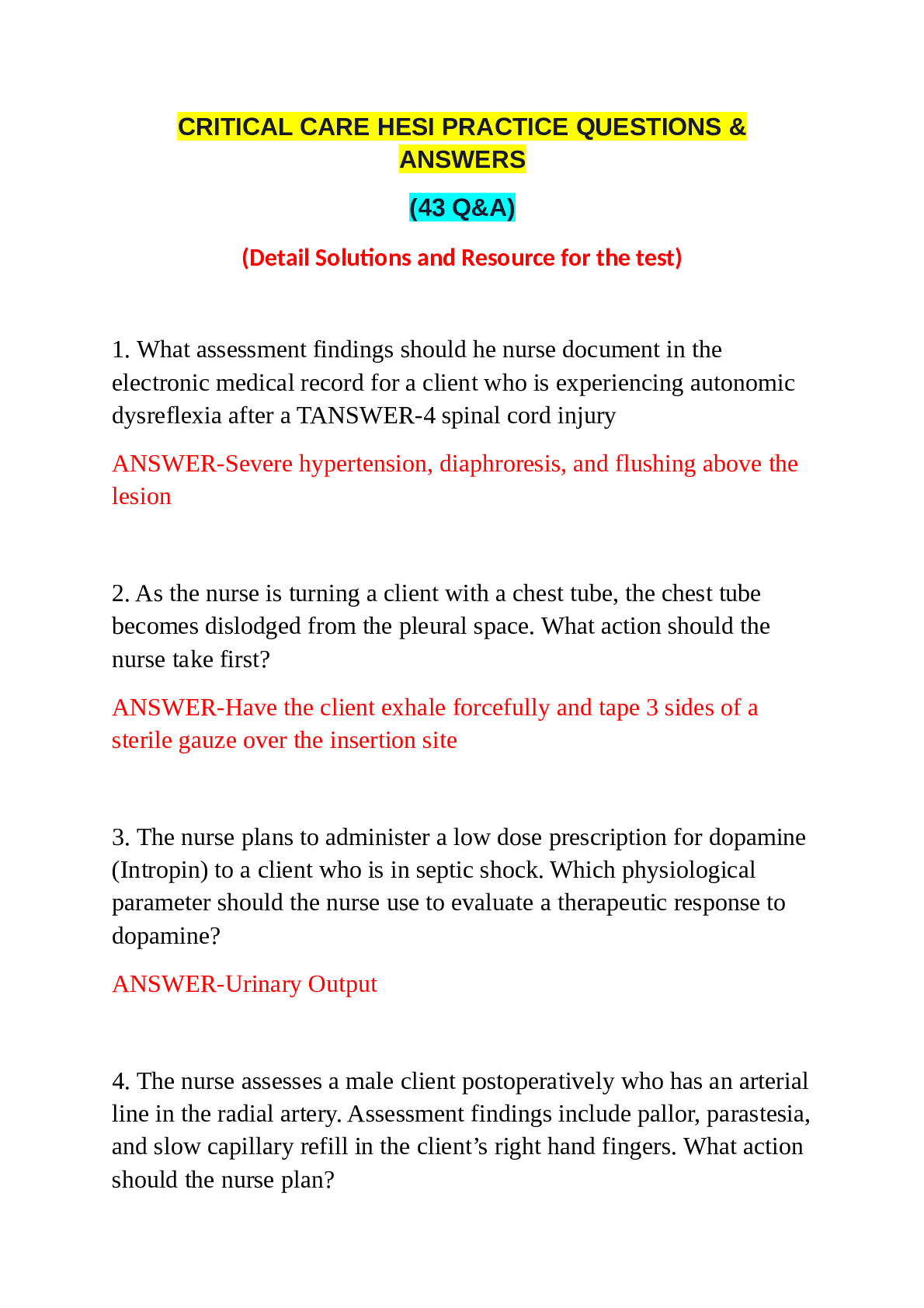
.png)
